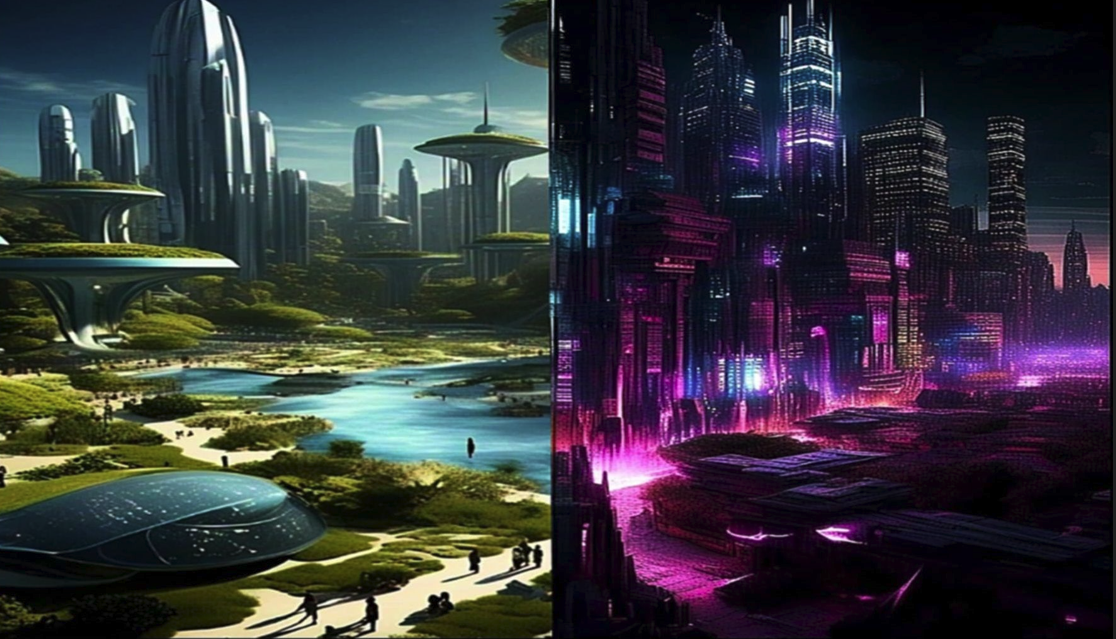Time and Space died yesterday. We are already living in the Absolute, since we have already created eternal omnipresent speed.” — F.T. Marinetti (1909)
“It seems..as if the cloud could carry everything away with it: sorrow, steel, screams.” — G. Bachelard (1943)
“..to transcend our own humanity. Or perish in a toxic mental cloud of our own making, when our civilization reaches its point of singularity.” — J. Vallée, (2021)
A question from Messenger: “In your writings you suggest that Hypermodernity began sometime between the mid 1990s and 2012, dates which correspond to the beginning of the World-Wide-Web [1995] and then the ‘iCloud’ [2011]. But what do you mean by “hyper-modern” compared to the “postmodern”?
The Hyper is, for me, synonymous with the “Absolute” (Hegel’s “sum of all being, actual and in potential”); or something like the logical fate-destiny of the Absolute — “as the logical Idea is seen to unfold itself in a process from the abstract to the concrete.” More completely: the Hyper is what I call the Absolute’s nominalized literalization — or, more properly, its hypostatization.
And this is its key idea.
At the end of Western Metaphysics (“Philosophy understood as Platonism”), the Absolute was freed from all metaphysical containers. But w/out a transcendental referent for the Absolute (for example as an attribute of a transcendent god, soul, or Platonic idea), and not being able to dissolve (or de-nominalize) a now reified Absolute back into the immanent pluralities (of primary experience), the Absolute fell into our average-everyday world — or into the colloquially “real.”
“Our world” is, consequently, now inflating to a point of absolutization (e.g., the culturally prevalent discourses of accelerationism and millenarianism, and the meme of the Techno-Singularity, etc.).
This is a process of sublimation or volatilization — the alchemical sublimatio: becoming vapor; hence, the autochthonous emergence in 2011 of the icon of the Cloud (icloud). Notice how the Cloud fills the “semiotic vacancy” that was left behind since the erasure of the cross from our social and institutional spaces ( — in the United States the Cloud is even more conspicuous than the National flag).
The icon of the Cloud tells us how we imagine information and also the storage-medium of information today (e.g., nonlocal, telepresent: “cloud-storage”). But that means, it also tells us how we imagine ourselves and the world today: as vapor.
The postmodern was liquid.
After the medieval era and throughout the modern, the major onto-epistemic (or metaphysical) infrastructure would still hold the Absolute in place — as the absolute categories of systems like mind-body dualism and Transcendental idealism and the absolute distinctions they drew between concepts (e.g., the Cartesian heritage of subject/object, intensive/extensive, etc.; or the Transcendental categories of Kantianism and the absolute closure of the noumenal.) But eventually that infrastructure would be stripped of its “transcendental signifieds” like the bolts that held together the structural frame of a skyscraper — and by the middle of the Twentieth century, not much of it remained that wasn’t yet in the heap of melting slag and fallen sky.
Zygmunt Bauman’s term “liquid modernity” aptly described the post-modern phase that would follow — evoking the alchemical metaphor of the liquefying solutio that characterized modern life in that Post-Industrial era and the disintegrative effects of the beginnings of electronic globalization after WWII.
But, the Absolute is by definition indissoluble. It was fated to fall into the world, where its destiny has taken the form of electronic globalization in its hypermodern phase as the World-Wide-Web — which absolutizes the world, evaporating beings and flows, into a final, no-longer divisible (ab-solute) form: the one-&-zero of digitization.

Hypermodernism will not be focused on the alchemical solutio, i.e., with the liquid or hydrological aspects of postmodernity, but with a new phase of modernity that we don’t understand yet, and that we could call Vapor Modernity. “All that is solid melts into air,” as Marx famously said.
Anything that makes an absolute claim upon us is a thing that the Absolute has puffed-up. But never has the Absolute puffed-up any thing before now — or appeared as a nominalized supplement w/in the world before. As an attribute of the transcendent, the Absolute was properly adjectival — and it was those age-old “supersensibiles” alone that could claim us absolutely; i.e., as the revelations of religious or of metaphysical “meaning.”

The Hyper, the semiotic excess, is not only a way of talking about information overload or overflow; it is also refering to the way that our average-everydayness —since we’ve gone online— has puffed-up into a kind of veridical hyperbole. From the mundanities of race and gender and whatever innocuous “issues” instigating today’s Cancel Culture (for example), the most average things make an Absolute claim on us and our cultural discourse — in the way religious or metaphysical (“super-sensible”) demands once did.
According to the psychologist Wolfgang Giegerich, the Absolute is not only no longer a quality of the transcendent but it shows up as the absolute demand that is a psychopathology or a neurosis today. Agoraphobics are not merely afraid of stepping outside, they are absolutely afraid (phobic); just like addicts are not merely chemically dependent on one or another substance, which most human beings are (e.g., caffeine, nicotine, etc.) they are absolutely dependent; and just like the fetishist is absolutely obsessed, etc. (I could go on) — and the claim these neuroses make upon us is structurally similar to the way God or the Spirit or the True, the Good and the Beautiful were, once upon a time, absolute and made the absolute claims upon us.

The danger of the Absolutization of everything is that it leads to the total volatilization of things; and it suggests that we are destined for ever more rarified levels of atomization (e.g., intersectional identity, etc.) or even our total digitization (e.g. the neurological connectome). We are destined to disappear somehow, to become air; perhaps literally or in some other way — like vanishing into a worldwide neural-immersive cyberspace (not merely VR or “augmented reality” but integral reality, i.e., “hyperspace”).
Perhaps it is the case, after all, that the ultimate project of Western metaphysics — which although its own dependance on the notion of the Absolute brought about its own annihilation (nihilism) — was to be the very matrix for the technological instrumentalization of the Absolute in the present form of electronic globalization (i.e., the WWW) as a machine for evaporating the world, sucking everything up into the clouds, or Hypercloud.
I don’t know what that means, other than that the implicit nihilism of Western metaphysics has become explicit and literalized on a global-titanic scale — the fate of Metaphysics was the destiny of the Absolute (i.e., becoming Hyper).
As an optimist, I could say that this is all producing a new ground for human beings: somehow the Air is becoming our ground — a noetic ground, maybe even diaphanous to noesis. And perhaps that’s the necessary ground for beings like us who are best described as the ones with our heads in the clouds — i.e., by our Poetic Imagination and not reason or tool-making, which are only modes of the former.
Clouds give the appearance of both malleability and stability as if they call out to us to be shaped like aerial Play-Doh, into anything we wish. And perhaps Hypermodernity is setting the stage for some new form of poiesis, where we can invent our own future singularities (or “noetic vaporicities”) out of this new malleable reality as reality becomes increasingly imaginary, noetic, vaporous. (The current MSM discourse about UFO disclosure and also the theatrical spectacle of hyper-partisan politics are no doubt contributing to this process of irreality.)
But currently, Hypermodernity and its strange Integral Reality (i.e., the integration of the Real and its Imaginary), as Jean Baudrillard called it, are nearly totally under the control and moderation of a Big-tech oligarchy and the machinations of the political-class that ensures its immunity. They own the “Hyperobjects” and determine what is real for us by their own designs for the integration of the real and the imaginary e.g., in the form of products and narratives. Can we cut-up and shape this Integral Reality by our own designs into “new maps of hyperspace,” into authentically creative singularities, and for a better future?
At least me and my friends are working on it.





